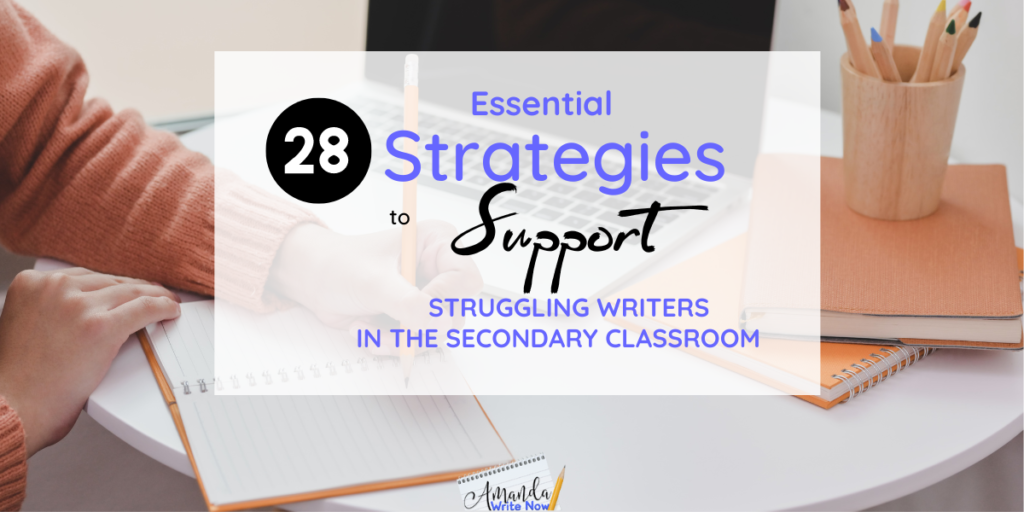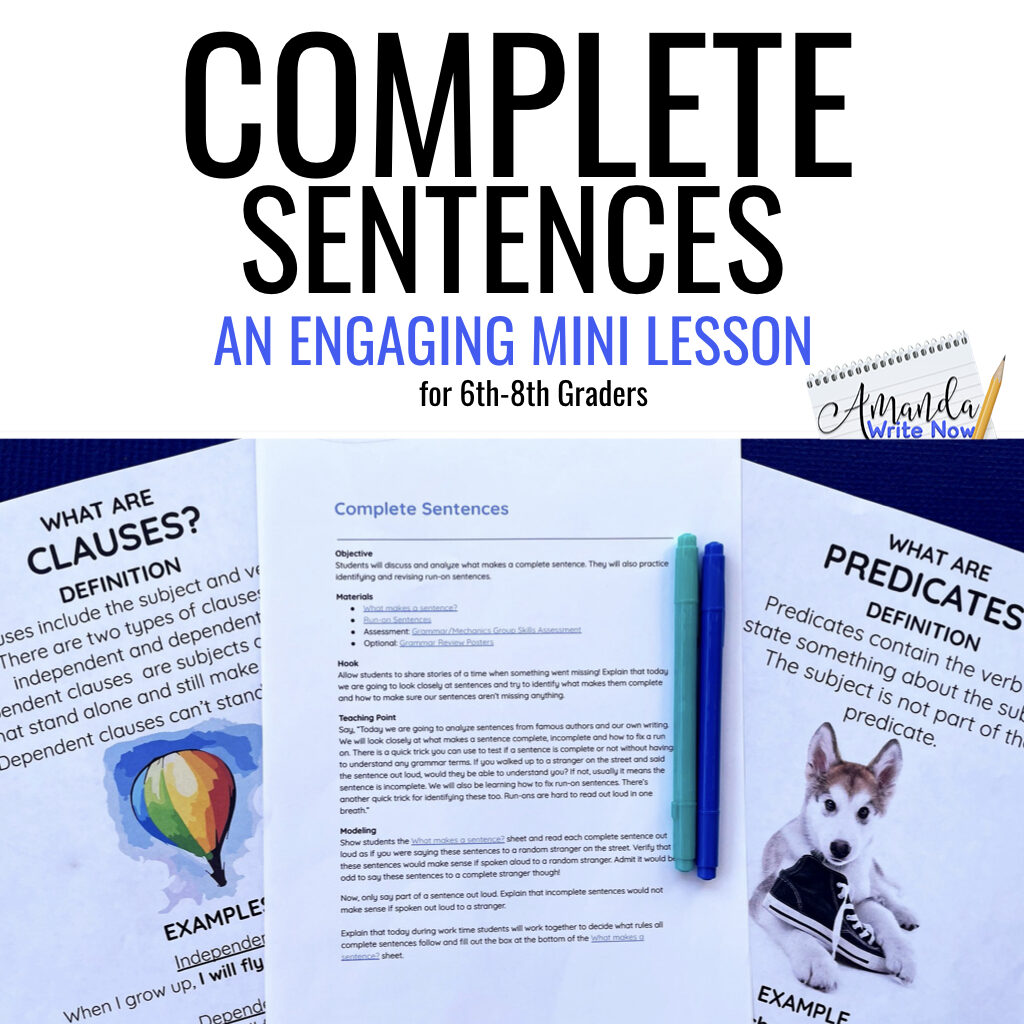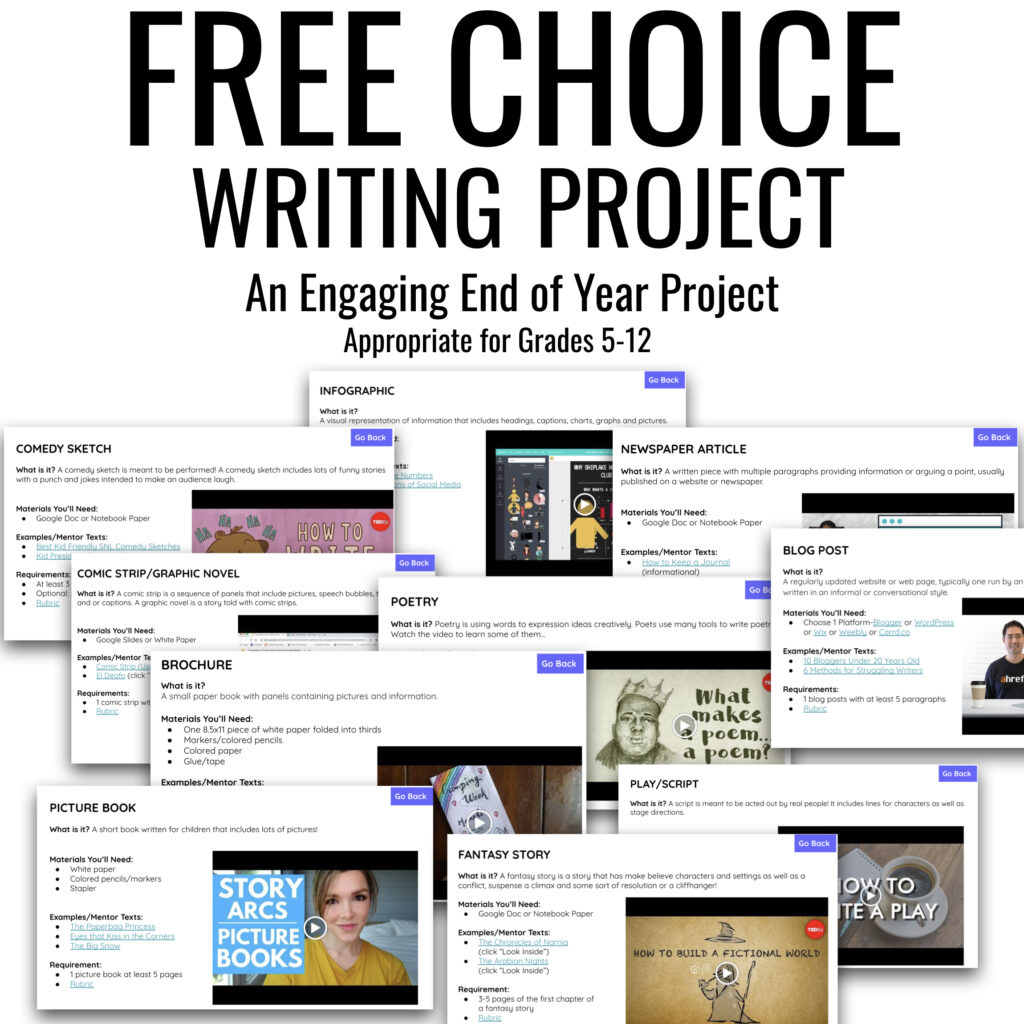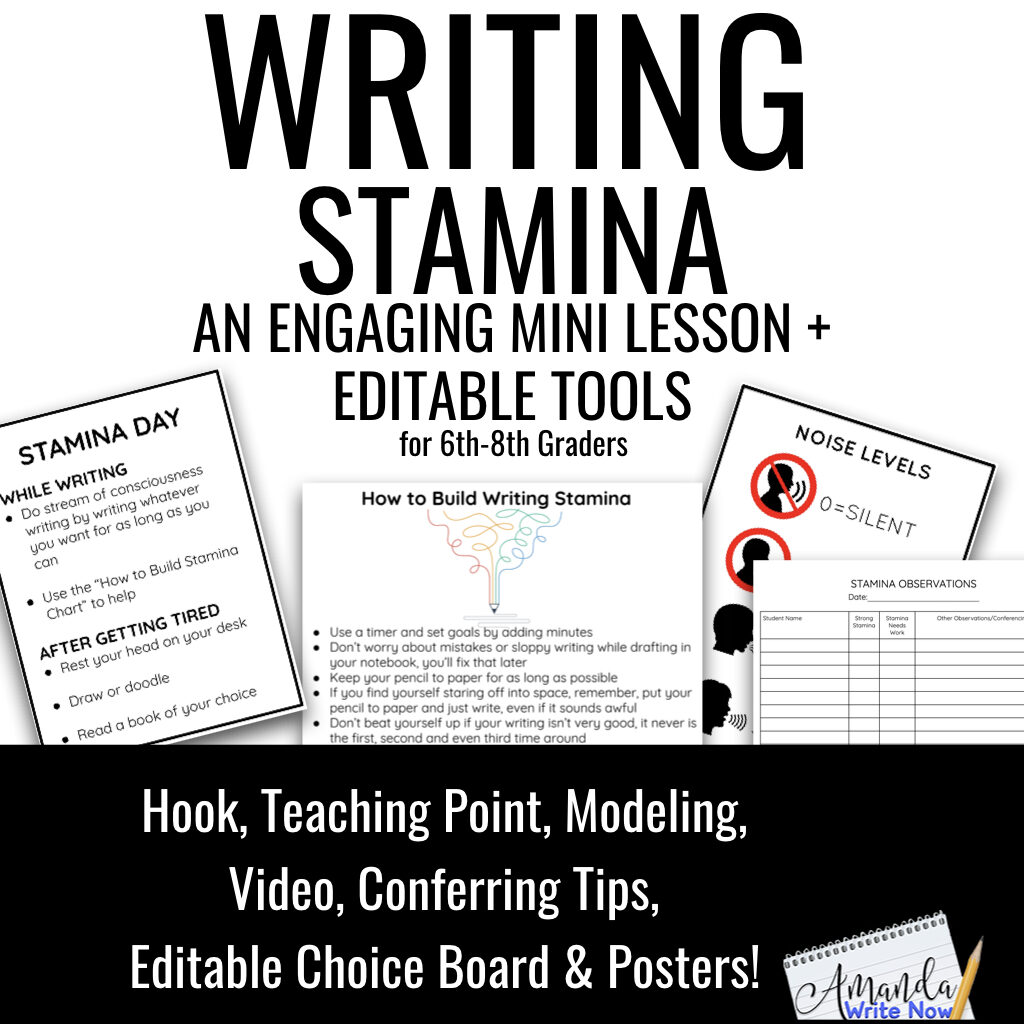
Every classroom has struggling writers. There are many reasons young writers struggle during our writing units.
They may feel overwhelmed, be uninterested, have writing skill deficits because of past experiences with writing, or have learning differences.
Often these struggling writers tend to be writing far below grade level and their writing abilities cause many unforeseen problems throughout their school careers. For struggling writers, any writing assignment no matter how small or big can cause anxiety, acting out, off-task behavior, or all of the above.
In middle and especially high school, the struggle with writing becomes even more problematic as expectations increase. In order to avoid the struggle, these students may get other students off task. Or they may ask for help incessantly or suffer in embarrassed silence.
For all of these reasons and more, it’s incredibly important for writing teachers focus on building confidence in these writers. To do that we must have a toolbox of strategies they can pull from to support these struggling writers.
The good news is that this blog post has twenty-eight essential tools you can utilize no matter what type of struggling writers you have and no matter how their struggles show up in your classroom.
1. Focus on 1-3 Skills
The best way to support all struggling writers is to reduce their overwhelm. Writing is a tough subject to master because of the plethora of skills required to be an effective writer. Teachers can ease the burden by making it clear to struggling writers which skills from the rubric will be graded. Struggling writers often need help in basic skills such as writing a complete sentence, varying sentence structure, revising run-on sentences, using capital letters, writing body paragraphs, and putting ideas into a logical order. The resource linked below can help you develop mini-lessons specifically for practicing these skills. Just remember to only focus on 1-3 skills at a time!
2. Mini lessons
Because writing is such an overwhelming subject, writing instruction should be done in short 10-15 minute bursts. Teachers can tend to be wordy and long-winded. Using a timer to limit your mini-lessons can be incredibly valuable. Struggling writers can only take in so much information before they completely check out. Mini lessons can also be utilized during small group instruction and one-on-one conferences too! Continue reading about these strategies below…
3. Retrieval Practice
If you want students to retain the information they learn in your class then retrieval practice is vital. Retrieval practice involves revisiting a skill you taught the day before, the next day. Directly ask students to demonstrate the skill, discuss the skill, or write about the skill you discussed the previous day. The more you can incorporate retrieval practice in your class, the more students will have opportunities for repeated practice and be more likely to retain and utilize the skill in different contexts.
4. Choice Boards
Choice boards are a list of activities students can choose from during independent writing time. I always provide students with a choice board after my mini lesson and it’s time to send students off to write independently. This choice board usually has a list of five different activities to choose from. Often it includes, working on your draft, getting help from your writing partner, working on a graphic organizer, reading a mentor text, or watching a video
5. Choice Topics
In order for students to take ownership and be motivated to write, we have to give them choices when it comes to the topic(s) they write about! We can choose the genre such as personal narrative, informative, or argumentative. But, when it comes to the topic, it’s important we allow students to pursue ideas and topics that are most interesting to them and pique their interest.
6. Sentence Starters
These are like mad libs for getting ideas for writing. Teachers can utilize mentor texts to create sentence starters. For example, if students are writing an informative article they might use lines from this article such as “Researchers from…uncovered…” or “This is not the first time…was found…and it won’t be the last.” Sentence starters can also be provided for adding transitions to writing, “In the beginning”, “Afterward”, “First, Next, Then, Finally” are all examples of sentence starters.
7. Writing Prompts
Sometimes giving students choice because we want them to be invested leads to overwhelm. When this happens, writing prompts can be really helpful. There are tons of writing prompts for whatever topic you want, Google is your friend when it comes to writing prompts. Here’s a wonderful resource for writing prompts for all types of genres.
8. The Writing Process
The writing process can be messy and recursive but it can also help break down writing into steps for students who struggle. Just to refresh your memory, the basic writing process is brainstorming, drafting, revising, editing and publishing. If students know this process they can run quickly through the whole process, struggling writers often do or they get stuck on one part of it. If and when students race quickly through it, it becomes the perfect opportunity to teach the recursive aspect of the writing process. You can make students go through it again with the same piece of writing or have them start a whole new piece of writing.
8. Graphic Organizers
These tools help students see the entire structure of a genre of writing. A plot diagram or the hero’s journey could be considered a type of graphic organizer for personal narrative or fictional writing. A two columned table, ven diagram, list, and outline could be considered types of graphic organizers for informational and argumentative writing.
9. Make Writing
*Amazon affiliate link below-this means if you purchase the book, I receive a commission. I never recommend books I don’t absolutely love.
Angela Stockman is the leader of a new movement called, “Make Writing”. Learn more about it over on her website here. Stockman explains that print-resistant students need to be given the opportunity to build their ideas before expecting them to put those ideas down in print. This helps struggling writers build confidence in their ideas because for some reason or another they just aren’t ready to communicate via formal print, yet.
“Make Writing” is a way to bridge the divide. It involves using “loose parts” (post-its, legos, paper clips, pens, scraps of paper, plastic eggs, anything loose really) to communicate ideas. It all starts by asking a simple “fire starter” question: “How might you____________using these loose parts?”. For example, “How might you build your main character?” or “How might you argue this point?” or “How might you explain this concept?”. Students answer these questions by building with the loose parts you provide. Once they’ve built, they talk, and after they talk students write.
11. Step-by-Step Directions
Not all students needs explicit instructions, but some do. Every time you send students off to write indpedently there’s a group of kids who are going to need explicit, direct instructions to follow. If you forget to provide this, there will be consequences. So, after sending students off for work time go over to the students you’ve identified as struggling writers and provide them three step instructions, preferably written down. But, how might you keep up with giving separate instructions to individual students? See #12.
13. Voice Recording
Some of our students are much better at verbal communication than print. If you have students who struggle with print but are very talkative then voice recording could be an excellent tool for them! There are many voice recording tools available these days. You can even use Google to type your voice, it works I’m doing it right now. All you have to do is open a Google Doc, click>Tools>Voice typing and click record, and start talking! Students will get a lot of this experience and even become strong editors and revisors because when voice recording, lots of mistakes happen!
14. Collaborative Writing
Humans are social creatures and especially young humans, even shy, introverted students need and crave connection. Whenever possible, allow students who struggle with writing to write with another student they get along well with. Any unit you teach can be done collaboratively. Collaboration is a 21st century skill that is becoming more and more important in the technology age! Some teachers may wonder how to assess who did what…it’s easy if you use Google Docs. When you click “Last edit was…” at the top of the Google Doc, you can view all the history within a Google Doc and different collaborators show up in different colors too!
15. Drawing
Some students are natural artists and would be very motivated to draw their ideas for their informational article, argumentative editorial, or even personal narrative. Teachers need to allow creativity into their classrooms more. But, often English teachers can look down upon new modes of communication that don’t involve a lot of print. If we want to reach our struggling writers, we need to have an open mind about how they communicate their ideas to us.
16. Speaking
When voice typing doesn’t motivate a student, sometimes just speaking to you or another student can get these students moving down the right track. Students who are very oral can benefit from talking out their ideas before writing them down. These students may need a lot more talking time than you’d expect though. They might also need you or another student to write down what they say. This is a great accommodation for students who are very resistant to writing but it can be time-consuming.
However, all students benefit from lots of speaking before writing, so make sure to embed this practice into your classroom routines. Often, when you allow students to speak for five to ten minutes first before settling into writing, they are more productive and quiet when it’s time to write. Make sure to use a timer though, so students know when the speaking time ends, the silent time begins and when the silent writing time ends.
17. Writing Fun
Do you let your students write slam poetry, scary stories, fables, fairy tales, what about allowing students to write fiction in general? Have you ever tried whole group writing where the entire class is involved in creating a written piece together? If the answer is no, then you aren’t providing enough fun in your writing class. Students need to be exposed to how exciting writing truly can be! Pair this strategy with collaborative writing and you’ll be sure to have an engaged class begging to write more!
18. Small Groups
Teaching mini lessons to small groups of students can be a powerful way to provide immediate feedback and help tailored to the students in front of you. These groups must be fluid and flexible from day to day though. There is a danger in grouping all the struggling writers together and meeting with them on a regular basis to remediate. It can cause social outcasting, low self-esteem, and low motivation. So, make sure you don’t fall into the trap of grouping all the struggling writers together. Rather, have a few mixed groups meet based on the skills you are working on together, not based on some broad determination that they are struggling.
19. Mentor Texts
Mentor texts are any piece of writing that serve as an excellent example of the type of writing you are expecting students to do. Students need to be taught what mentor texts are and explicitly how to use mentor texts to help them in their writing. Mentor texts should be utilized with your whole class during mini lessons. But, they can also be an excellent tool to pull out when conferencing with struggling writers. Just like with sentence starters (#5 from above), mentor texts can be used like mad-libs for struggling writers. Pull sentences from the mentor texts. Leave some parts of the sentence blank and have your struggling writer try to complete the sentence.
20. Conferencing
I recently wrote about how every writing teacher needs to start rethinking conferencing with equity in mind. The bottom line is that in order to treat our students fairly and have more equity in our classrooms, then we have to give students what they individually need. Students who struggle with writing need more help than other students and therefore we need to meet with these students more. Instead of trying to conference with all your students equally, keep equity in mind, and conference with the students who need it most, more regularly.
21. Stamina Practice
Stamina is being able to do a challenging activity for a long period of time. Students need to be taught about writing stamina and how it takes time, goal setting, and lots of practice to build stamina with writing. I like to tell my students that we all have strengths and weaknesses. In areas of strength, stamina can come easily. In areas of weakness, we must make a concerted effort to build stamina. Each time you expect students to write silently for a sustained amount of time, call it stamina practice. Set a timer and have students document how long they are able to sustain their attention on writing. Have students track their writing stamina over time, set individual goals, and celebrate when they’ve achieved them!
22. Clear Purposes
Often in schools the purpose of writing is for a grade from the teacher. This is not motivating to struggling writers or even talented writers. We need to flip the script if we want students to be motivated to write. Every single time you have students write something, explain the purpose behind it. Maybe the purpose is to build stamina, to share with peers at the end of class (always make this voluntary and optional, especially if the writing is about personal topics), to have a class discussion, or to share with the public somehow. When you conference with your struggling writers, make sure they are clear about the purpose for writing that day!
23. Clear Audiences
Just like with making sure students have a clear purpose for writing, they also need to be told who their audience is for writing each time you assign writing. However, remember writing is deeply personal and a lot of struggling writers might be embarrassed and feel extreme anxiety about sharing their writing. This is why, even if we are publishing our writing in some way as a class, maybe by participating in a contest, sharing our writing in Google Classroom, or reading it aloud to peers, I always make this optional! Maybe you are thinking, but if I make it optional, no one will share! That’s not true if you reward students for sharing with a bag of chips or a lollipop. Yep, bribes do work and sometimes we gotta do what we gotta do to make writing fun and exciting for students!
24. Writing Celebrations
All students need more positive experiences with writing. Once a writing unit has been taught, secondary teachers often feel they need to get to the next unit quickly. This is a huge missed opportunity to help students develop positive associations with writing. Check out this blog post about ten ways to publish writing for inspiration about how to celebrate your students’ writing accomplishments.
25. Grading Transparency
Students need to be told explicitly how they will be graded for every piece of writing they do. Some writing is process writing and will receive an in-process grade (a grade for completion), but some writing is summative and needs to receive a summative grade. Struggling writers often benefit from having a pared-down rubric for summative assignments. So, your rubric might have eight writing skills listed, however, you might choose to only grade three of the eight skills. Explain this to your struggling writers. Highlight their rubric so they can literally see the skills they are working on during writing time.
26. Checklists
Students can greatly benefit from having a checklist to work on during independent writing time. But, this only works if students understand what’s on the checklist. In order to ensure students understand, make sure your checklist is kid-friendly, and written in simple language. Also, every time you teach a mini lesson have students pull out their checklist and explain which item on the checklist you are teaching about that day.
27. Self-Assessment with Rubrics
There have been a lot of studies done demonstrating the profound positive impact of self-monitoring with rubrics on students. During conferences, have students use language from your rubric to discuss their writing and have them self-assess with you as an informal evaluation. By doing this, students get practice understanding the terminology on the rubric and connecting it to their own writing. Also, have students self-assess using your rubric before turning in their final piece to you. This way, students are fully aware how you will assess their writing and you are fully aware of how students felt they did on specific writing assignments.
28. Breaks
Teachers underestimate the number of breaks secondary students in general, and especially struggling writers, need. Think about the demands we place on children each day. All humans, especially children, are social and physical creatures. In modern-day society, we expect a lot of young people. We push them all day long with our work demands and secondary students tend to have 6+ teachers placing different demands on them. We need to let up! We need to give students downtime in our classrooms.
We all need rest in order to be fully productive. For struggling writers, this might mean you give them three steps to complete, and then they can take a break and do an agreed-upon activity such as taking a walk, getting some water, playing a game online, and even laying their head down on their desk for a while. Breaks are vital and we shouldn’t disregard them. If we do, there will be consequences in our classrooms in the form of off-task behavior, secretive, and even outright hostile behavior! Do you and your students a favor, and give them the gift of more breaks.
Wrap Up
I hope this lengthy blog post has armed you with best practices and strategies you can test out with your struggling writers. It’s important to understand that not every strategy will work for every student though. Sometimes, one strategy may work for a while, and then resistance sets in again. A great way to help our struggling writers is to take on the mindset of a scientist in our classrooms. Our job is to experiment to see what works and what doesn’t, and to stay flexible. Are there any strategies not listed here that have worked for you and your students? Please share them in the comments below so we can continue to grow this strategy’s toolbox.






0 Comments